Final Film Project
In this episode, I explore my early experiences with sewing and how they led to my current skills, accompanied by an easy sewing project perfect for the first episode.
I was originally going to separate the two parts in the video, however, I kept it as one for this project for viewing purposes. I was also trying very hard not to go over the 5 minute mark, practicing the montage effect through out this video.
Enjoy!
View Post
FINAL ROUGH DRAFT
Film Rough Draft
Very Rough draft – I have been trying to upload my footage.
View PostWK13: Blog Post
Blog Post: Describe your final project idea. Which modules in this course will you explore (try for at least two): continuity, montage, looped video, composited video, AI cinema. networked video, HTML cinema or the video essay, etc.
My final project idea will involve a DIY YouTube sewing video that will be about 2 to 3 episodes long. One episode will most likely be about how to put a pattern together (particularly the pattern we will be using in the 2nd episode) and then either make another video on prepping the fabric with the pattern or combine the two into one video. The next video will be putting the fabric pieces together and where to sew to finish the project. One thing I need to think about is a small easy project that I can make in just a few hours – some take DAYS! I also need to think of a beginner-friendly pattern to use so that the video will be easy to follow along. With this project, I will use continuity and montage modules making sure that we are doing an in-order process from the start of the project to the end of the project.
View PostWK13: HTML Cinema Project
WK11: Video Essay
WK10: Blog Post
Blog Prompt: Bill Viola, writing in 1982 at the very start of digital video editing and video storage in a computer, speculates about the future possibilities of “data space” as a kind of potential space that can be explored by a “participant.” How does his vision compare with the branching Netflix movie Bandersnatch? Is Bandersnatch entertaining or tedious? Does the work point to future possibilities for cinema and storytelling? How do Viola’s ideas, drawing on sacred arts of the past, challenge the simple “choose-your-own-adventure” approach to the nonlinear potentials of digital cinema? Where do you think this technology is headed? Please quote from the reading.
“Something extraordinary is occurring today, in the 1980s, which ties together all these threads. The computer is merging with video. The potential offspring of this marriage is only beginning to be realized. Leaping directly into the farther future for a moment, we can see the seeds of what some have described as the ultimate recording technology: total spatial storage, with the viewer wandering through some three-dimensional, possibly life-sized field of prerecorded or simulated scenes and events evolving in time. At present, the interactive video discs currently on the market have already begun to address some of these possibilities. Making a program for interactive video disc involves the ordering and structuring (i.e., editing) of much more information than will actually be seen by an individual when he or she sits down to play the program. All possible pathways, or branches, that a viewer (“participant” is a better word) may take through the material must already exist at some
place on the disc. Entire prerecorded sections of video may never be encountered by a given observer.”
“Bandersnatch” shows how stories can change based on viewer choices, making watching more interactive. While this idea is fresh and interesting, some people find it tiring because there are so many different endings to keep up with. This mix of reactions shows the ups and downs of making stories like this.
Viola’s thoughts on storytelling predicted things like “Bandersnatch,” pointing to a future where stories might be more about exploring and participating than just watching. This could change how we think about movies and digital stories, making them more about joining in and less about just looking on.
Overall, Viola’s ideas and thoughts, were spot on.
View Post
WK8: Blog Post
Blog Prompt: Watch the above videos that introduce the popular video essay form and its history in the “essay films” from the past, and then look at some video essays on your own. Do a search on YouTube or maybe you have a favorite.
In a post, share the video essay along with your thoughts/opinions about the use of language (spoken and/or on-screen text) with image. How are voice-over, text, sound, graphics and video combined to explore an idea or make an argument? How would you begin “writing” your own video essay?
When my husband and I watch some of our favorite YouTube shows, we often get absorbed in informative essays about fishing techniques, prime fishing spots, and equipment. These videos blend footage of locations with close-up shots demonstrating knot tying techniques, all accompanied by informative voiceovers or explanations.
In creating my own video essay, it’s crucial to choose a compelling topic and plan the shots I want to capture. This typically involves brainstorming ideas on paper and sketching scenes I aim to portray. I particularly appreciate when creators incorporate music for smooth transitions, gradually fading it out to allow viewers to focus on the narration or explanation that follows. Also, making sure that the footage is matching along with the description of the voice over is also important.
View PostWK9: Video Essay II – My Favorite Place
WEEK 6: Loops Video
WEEK 8: AI Cinema Project – Video Essay 1
WEEK 7: AI Cinema Story
Blog Post: Using ChatGPT have a chat to explore a short “story” idea and its visual style that you can use to generate AI video clips (30-60 sec) for the AI Cinema project. Finalize a 200-300- word summary of a story or idea for your AI Cinema project. Post this in the blog. This will be the framework for your prompts. Also, in a separate paragraph, describe the look or style you want to aim for. You can reference directors, genres, or specific films, but also use words to describe the quality of the image: film stocks, cameras, lighting, color/bw, production design, sets, costumes.
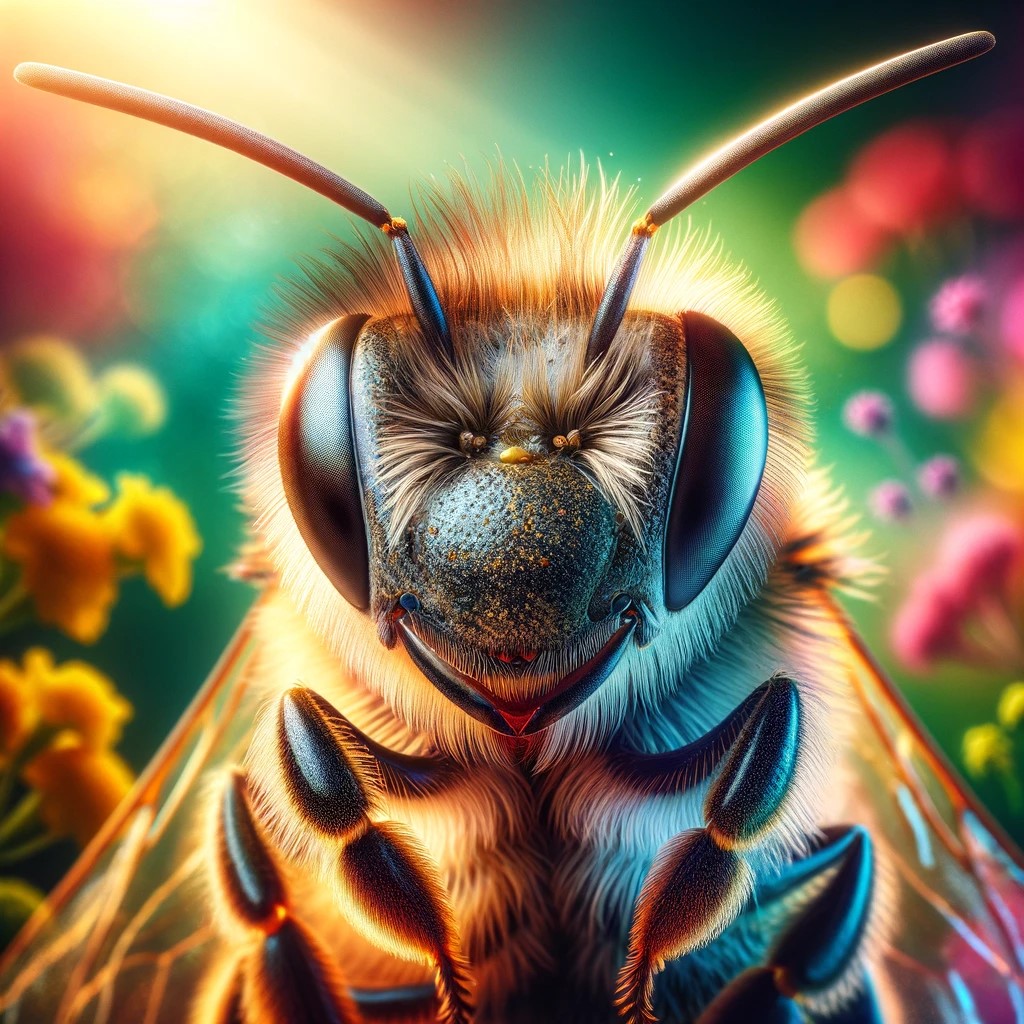
In the heart of a vibrant garden, bustling with life, resided Bella, a diligent little bee with a golden glow. Each morning, as the sun cast its first light, Bella embarked on a crucial journey, one that intertwined her destiny with the flowers around her.
One day, Bella discovered a rare, withering flower, hidden in the garden’s shadows. Its petals drooped, craving the touch of a pollinator. Bella, moved by the flower’s plight, made a promise to revive it.
With determination, Bella zipped through the garden, visiting flower after flower, collecting pollen on her legs. She danced in the sun, her wings glistening, as she moved from one bloom to another, spreading life.
But the garden was vast, and the day was short. Bella pushed her limits, her tiny heart fueled by the promise she made. She ventured into unexplored parts of the garden, facing challenges: gusty winds, raindrops like boulders, and the ever-looming shadows of predators.
As the sun began to dip below the horizon, casting a golden hue over the garden, Bella reached the withering flower once more. With gentle care, she brushed against its heart, transferring the life-giving pollen.
Days passed, and the once-drooping flower stood tall, its petals vibrant and full of life, a testament to Bella’s perseverance. The garden thrived, a mosaic of colors and scents, each flower a note in nature’s symphony, all thanks to the tiny bee’s journey.
Bella’s journey was more than pollination; it was a tale of resilience, care, and the interconnectedness of life. In the grand tapestry of the garden, every creature, no matter how small, played a vital role. Bella’s story was a reminder that even the smallest actions could breathe life into the world around us, making it a better place for all.
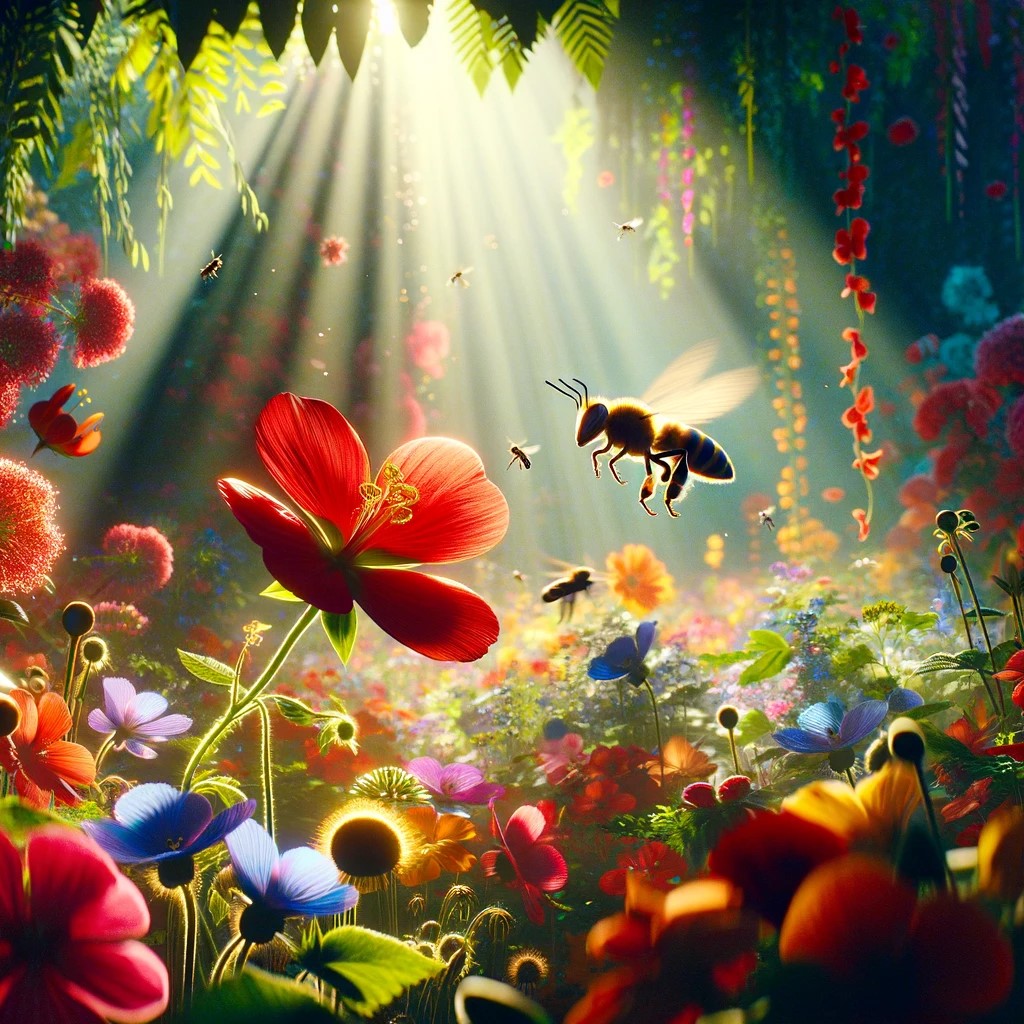
- Garden Encounter: The first scene depicts a lush garden teeming with colorful flowers. The bee is seen hovering over a bright red blossom, with sunlight filtering through the leaves, creating a lively and productive atmosphere reminiscent of a busy day of pollination.
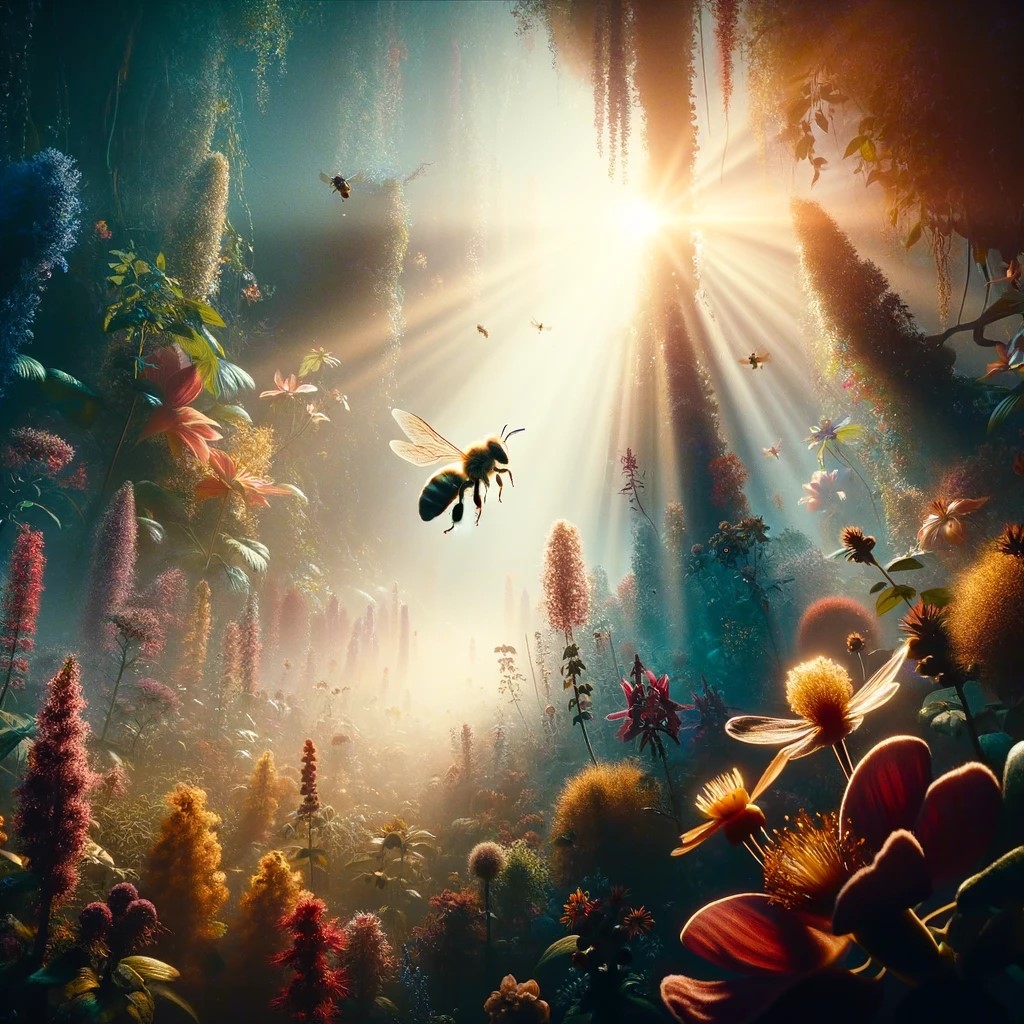
- Forest Navigation: The second scene shows the bee navigating through a dense, misty forest of towering flowers and plants. Sunlight pierces through the foliage, highlighting the bee’s path and emphasizing its determination as it moves from flower to flower.
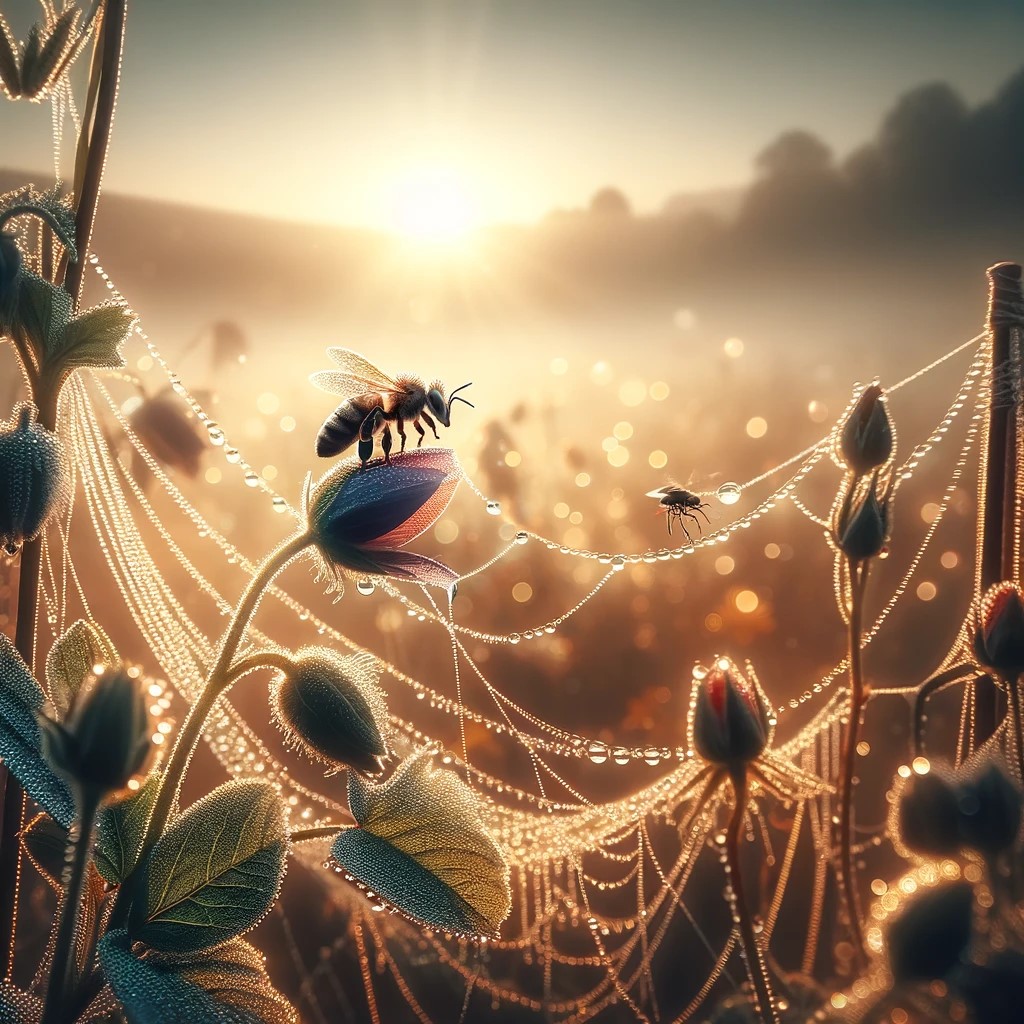
- Dawn Awakening: In the third scene, we capture the early morning tranquility in the countryside, with dew-covered webs and leaves glistening in the sunlight. The bee is gently landing on a dew-soaked petal, symbolizing the start of its pollination journey.

- Urban Oasis: The fourth scene contrasts the natural vibrancy of flowers against the backdrop of a bustling cityscape. The bee flits among urban flowers, showcasing the coexistence of nature and urban life and highlighting the adaptability of nature.

- Sunset Return: The final scene is set at sunset, with the sky painted in vibrant hues. The bee is silhouetted against the setting sun, marking its return to the hive after a day of pollination. The scene reflects the bee’s essential role in the ecosystem against a contemplative and stunning backdrop.
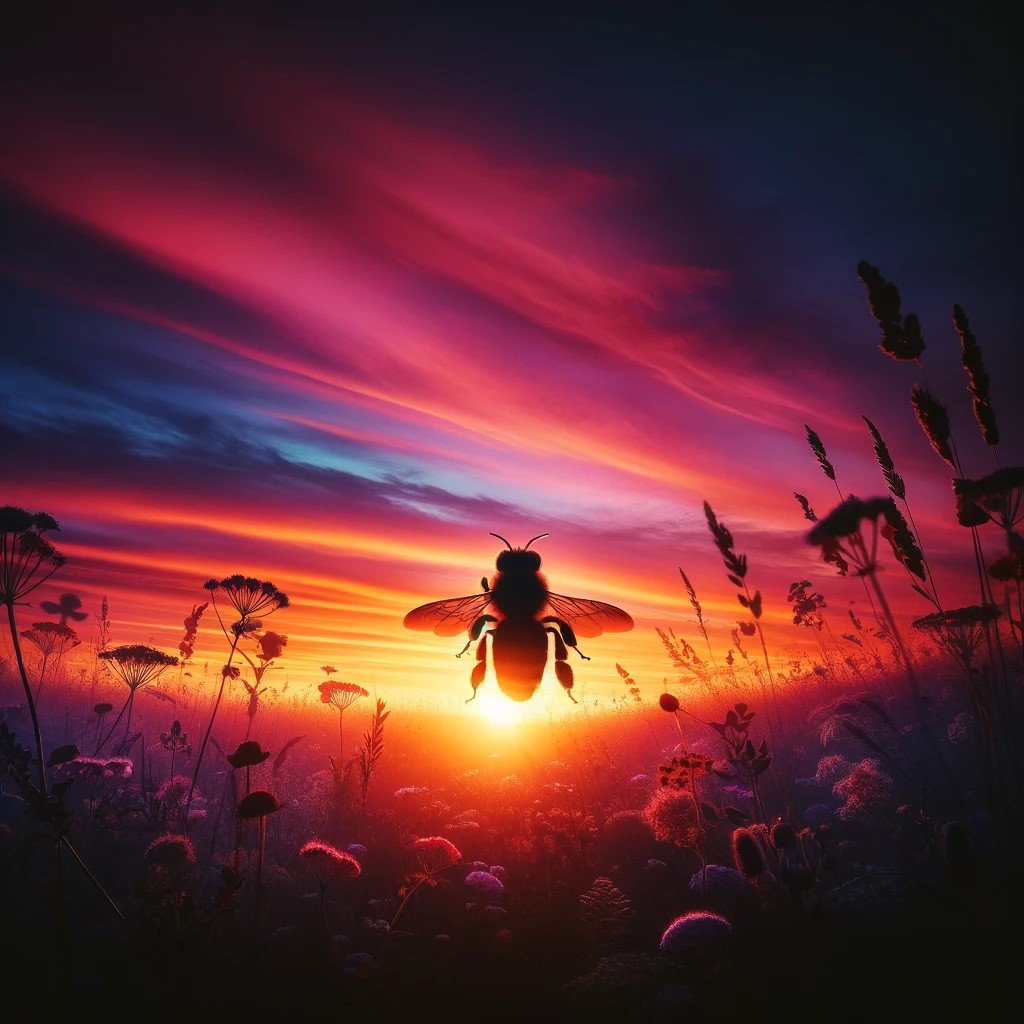
WEEK 4: Breaking Space
Breaking Space Assignment
Music from #Uppbeat (free for Creators!):
https://uppbeat.io/t/pryces/music-is
License code: IXPAXARJV15YKWPU
IN CLASS WORKSHOP: Continuous Loop
Continuous loop with a fade.
Samuel B & Miryssa C
WEEK 5: Loops
@mortadaaa_ #perfectloop #RufflesOwnYourRidges #ArbysDiabloDare #CloseYourRings #fyp #viral #like
This looped video embodies a cyclical pattern with a consistent rhythm. By employing editing techniques such as cutting and splicing, the creator repositions the video’s start to its end, initiating the loop at a midpoint. These types of loops are among my favorites due to their seamless continuity, giving the impression of an endless cycle.
This looped video, similar to the previous one, features a consistent, repeating action, encapsulating a cyclical theme. The editor skillfully applies the technique of placing the start at the end, effectively leveraging editing methods to enhance the video’s continuous loop.
Loop definitions from Chat GPT below:
- Cyclic: This quality refers to something that occurs in a repeated sequence or loop, suggesting a periodic nature. In the context of a video or GIF, it might show scenes or motions that restart after reaching a certain point, symbolizing the repetitive cycles in nature or life, such as the changing seasons, the moon phases, or the ebb and flow of tides.
- Slow: Slow motion captures moments with an extended duration, stretching time to allow a detailed observation of actions that would otherwise happen too quickly to appreciate. A slow-motion video or GIF can make transient, fleeting details visible and appreciable, such as the intricate movement of a bird’s wings in flight or the complex dynamics of a drop of water splashing.
- Timeless: Timelessness conveys a sense of eternity or an aspect that remains unchanged through the ages. A video or GIF with a timeless quality might depict scenes or subjects that transcend specific eras or moments, suggesting a universal or enduring relevance. This could be represented by natural landscapes that have remained unchanged for millennia, ancient architecture, or universal human experiences.
- Frantic: Frantic visuals are characterized by rapid, chaotic movement or activity, conveying a sense of urgency, haste, or frenetic energy. A frantic GIF or video might capture the hustle and bustle of city life, fast-paced movements in sports, or any chaotic scene with a lot of action happening simultaneously, creating a feeling of being overwhelmed or rushed.
- Rhythmic: This quality pertains to a regular, repeated pattern or flow, often associated with music or dance but also found in visual rhythms. A rhythmic video or GIF might showcase patterns such as the regular beat of waves on the shore, the synchronized movements of a group of dancers, or the repeating patterns of urban architecture, conveying a sense of harmony and order.
WEEK 3: Making Space
Music from #Uppbeat (free for Creators!):
https://uppbeat.io/t/night-drift/scuffle
License code: EETG2NEBTZPUIJ8J
Filmed and Edited by Miryssa Casas with Adobe Premiere Pro.
View PostWEEK 4: Time Frames
Blog Prompt: The art of cinema involves the manipulation of the viewer’s experience of time. The duration of a shot is like a temporal framing. In “Time Frames”, McCloud describes the various comics techniques for creating different temporalities. Reading McCloud, consider the framed panel in a comic as a cinema shot. Wider or longer panels are like shots with longer durations (“long takes”). Smaller panels are like shots of shorter durations. The main difference between comics and film is that with a page of arranged panels, the reader has a spatial “time map” in the simultaneous display of frames. In cinema, shots are mostly sequential and present an unfolding now. Discuss some aspect of McCloud’s visual essay that makes you think of the possibilities of time manipulation in digital cinema or of a certain movie scene that plays with time.
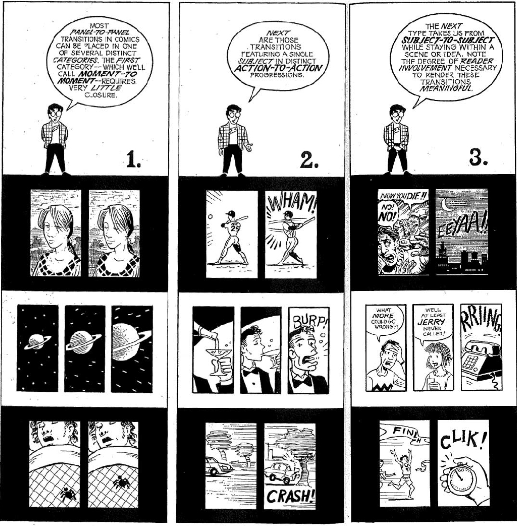
Some of the key points regarding time manipulation in comics and digital cinema, inspired by Scott McCloud’s “Time Frames,” include filmmakers’ experiments with non-linear storytelling, flashbacks, and the blurring of traditional boundaries. Opening up new storytelling possibilities really allows for more complex narratives and engaging ways to captivate viewers, enriching the experience. Another fascinating insight into time manipulation is how comics provide readers with a “time map” that enables them to see past, present, and future frames simultaneously. This offers a unique way of experiencing time. Digital cinema approaches this differently. Directors and editors begin to experiment with non-linear storytelling techniques, parallel editing, flashbacks, and the use of digital effects to alter the perception of time.

WEEK 3: Autumn Mists by Dimitri Kirsanoff
Blog Prompt: Watch the 12 min silent 1929 film by Dimitri Kirsanoff called Brumes d’automne (Autumn Mists). In this experimental short there is no plot just the visualized thoughts of a woman. Describe the editing. What is she thinking? Does the montage work? Does it evoke something for you? Kirsanoff said that his intention in the film was to represent a state of mind “through drastically changed images in which nature was losing its density and unity.”

Editing
- The editing is innovative because of the fluidity and juxtaposition of images.
- Uses techniques like cross-editing, superimpositions, and fast intercutting.
- Establishes a rhythm that aligns with the protagonist’s mental state.
What is she thinking?
- Her thoughts are abstract and is reflected in the contemplation of nature, life, and longing.
- There is no concrete narrative. The montage allows the viewers to project their own interpretations of the film.
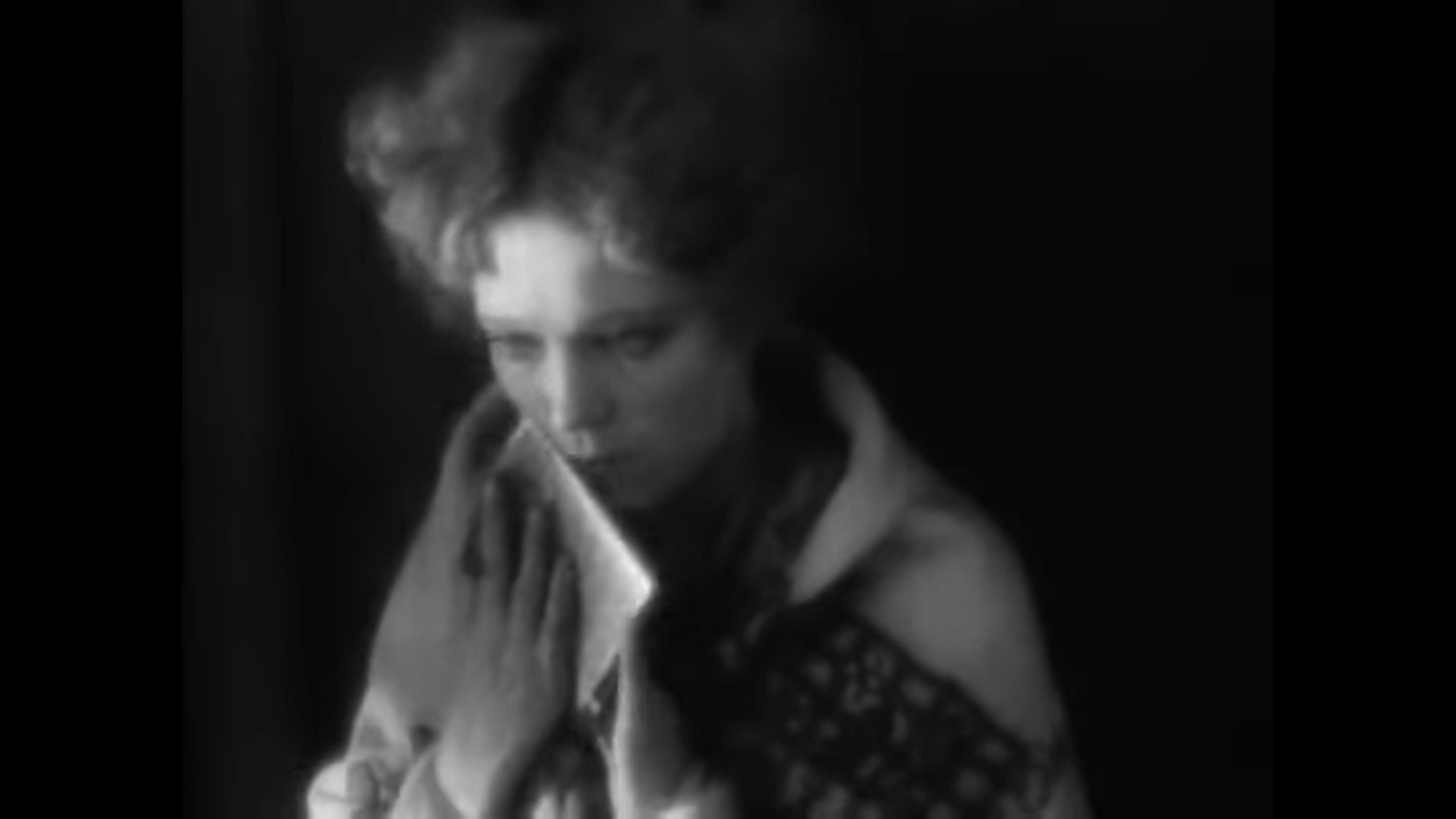
Does the Montage work?
- This montage is effective since it conveys thoughts and emotions without dialogue or an explicit narrative.
- Engages with the viewers imagination and emotions which creates an immersive experience.
- There is a blur between the lines between reality and abstraction.
Does it Evoke Something for You?
- The abstract and poetic nature of the montage creates a dream-like feeling.
- The montage creates a mood that makes viewers feel nostalgic longing or sad fleeting moments, possibly ones you have had in the past.
- The film uses visual metaphors such as the seasons changing or the shifting of landscapes.
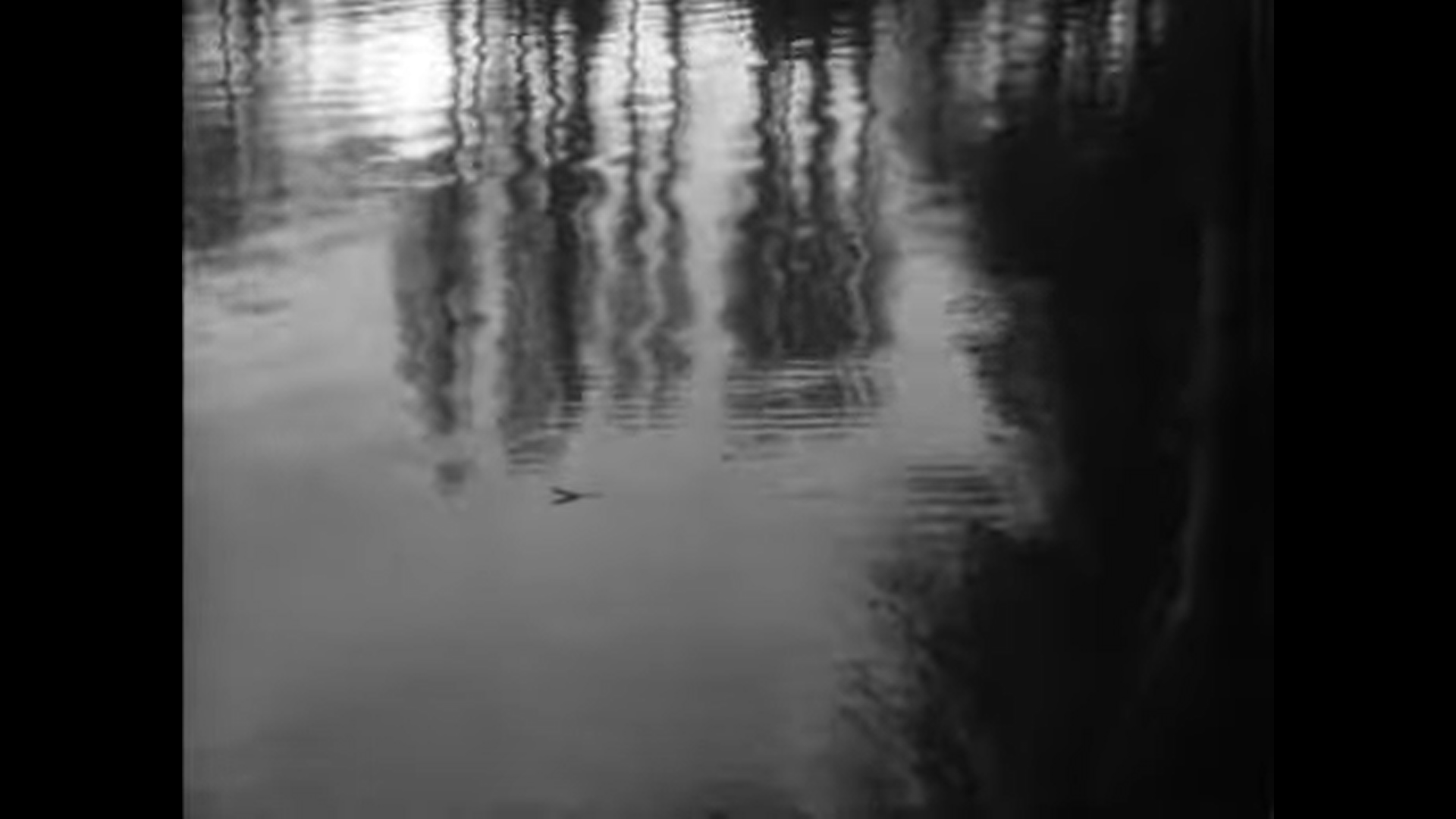
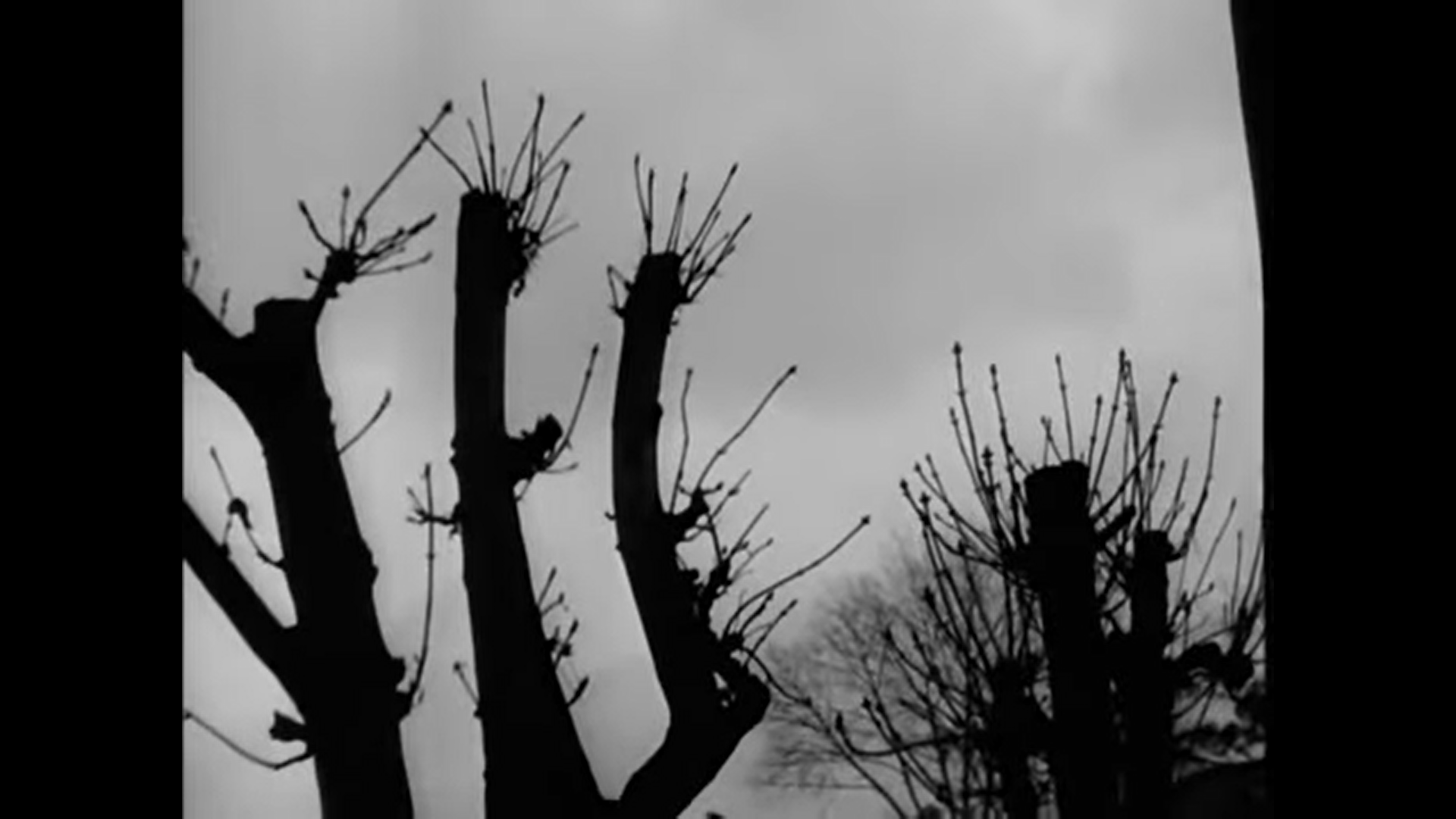
WEEK 2: 30-60 Second Day Film
Filmed on GoPro Hero 9 & Edited in Adobe Premiere Pro by Miryssa Casas.
View PostWEEK 2: Run Lola Run
Blog Prompt:
Although Run Lola Run has a discontinuous style – made of many types of cinematic images, including color, black and white, animation, video and still shots – it is held together as a whole by following rules of continuity to keep the viewer oriented in the fragmented spaces and times.
How does the movie retain narrative momentum despite all the time shifts? What narrative forces/desires drives the edits of shot to shot? In what ways is time “stretched” or “compressed” and how is the effect achieved? These questions are only “prompts” for your own thoughts about the narrative, cinematography and editing styles of the Run Lola Run. Take screen grabs to support your thoughts.
———-
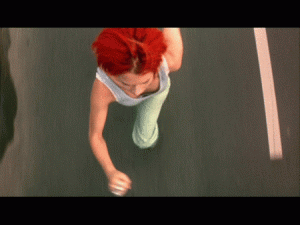
Throughout this narrative, the momentum is sustained through the repetition of scenes with, time pressure, music, and dynamic cinematography. The film’s discontinuous style primarily focuses on three different scenarios with slight variations, creating a structure that propels the story forward. Lola’s race against time to save her boyfriend serves as the central force, influencing the director’s choices of quick cuts, specific camera movements, and unconventional shots. The music further amplifies the urgency of her mission to rescue her boyfriend. Additionally, the film employs time loops, montage, and split screens, contributing to its non-linear structure.
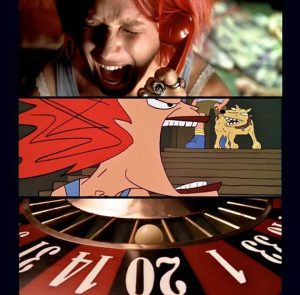
WEEK 1: Hi everyone!
Blog Post: Introduce yourself to the class in a blog post. What is your background or interest in video? Post a favorite video (from youtube/vimeo) that is in a style or approach to video you would like to pursue in this class. Tell us why.
Hello! My name is Miryssa and I love making videos about anything that happens in my life. One day I hope to show my kids how silly their mother is and maybe reminisce about the old times. My husband and I enjoy watching Addicted Fishing on YouTube, which is a local crew that tells us all their secrets about their techniques.
https://youtu.be/HFbr-y5OiXA?si=gN-ZOuOmq497H-9n
-Miryssa
View Post